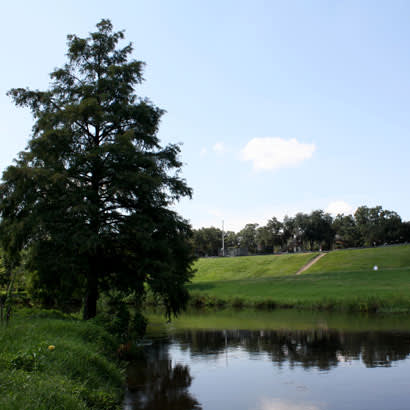
The Houston Parks and Recreation Department has begun a project to restore native flora to riparian areas — along rivers or bayous — at 70 parks in the city. This project, though worthwhile on its own terms, will also substantially improve the quality of life for everyone in Greater Houston by helping to mitigate the risk and impact of future floods.
To be sure, this riparian-restoration process will be no small undertaking. To determine which Houston parks were suitable for this sort of habitat revitalization, department staff inspected aerial imagery of every park under the stewardship of the city of Houston and found that, of the 370 total parks, 70 contained land that ran along flowing water: bayous, creeks, streams or ditches. At these 70 parks, the department’s Natural Resources Management Program team will clear the riparian areas of invasive plants, such as the Chinese tallow, that were brought from elsewhere and plant native flora instead.
Some parks have riparian habitats that already contain native plants and just need to be supplemented, while others lack any habitat at all along their bodies of water and will need to have it restored from scratch. Altogether, the department predicts it will plant more than 200,000 trees on 1,000 acres of parkland as part of this riparian-habitat restoration project. The project is funded through grants, and, according to Kelli Ondracek, Houston Parks and Recreation Department’s natural resources manager: “The cost will vary, based on whether we are creating the riparian area or just enhancing it, and the degree of invasive vegetation currently at the site.” It’s estimated that the entire project will cost about $15 million.
The Houston Parks and Recreation Department happens to think there is a certain aesthetic appeal to the idea of taking a tiny part of Houston’s 400,000 acres and restoring it to the way it looked. Indeed, the way the entire city must have looked, for thousands of years, before migration and commerce gave residents the environment they know today. This process of transforming Houston was largely inadvertent: No one set out with the specific goal of taking a large plot of wetland on the coastal plains of Texas and covering it with St. Augustine grass. Instead, economic and political realities motivated Texans and Houstonians to act in such a way that has resulted in the city we have. Houstonians do, however, have the power to be deliberate about what kind of city they want to live in, and in these riparian habitats in their parks, the park department is choosing to reverse the process that its predecessors unintentionally carried out.
There are more than aesthetic reasons to support this initiative by the Houston Parks and Recreation Department. For the past three years, the city has experienced historic flood after historic flood, and Houstonians are rightly concerned about whether the city will be prepared for, and be able to cope with, the aftermath of the next spell of heavy rainfall or the next major hurricane. Riparian restoration along Houston’s major bayous will help to mitigate the risk of flooding of those bodies of water.
Minimizing Erosion and Contamination
According to the Sustainable Green Initiative, the root systems of trees “create space between particles of soil”. Trees and other vegetation located near a river, physically impede the rainwater, slowing the flow of runoff down a riverbank and giving the soil more time to absorb it.
Recent floods have shown Houstonians what can happen when the city’s major bayous raise over their banks. The Houston Parks and Recreation Department’s habitat-restoration will largely occur along these bayous, giving these riparian areas a greater capacity to hold the rising floodwaters during heavy rain events.
When flooding does occur, the floodwater is prone to eat away at river banks. The dense vegetation will help reduce the risk of erosion. The United States Department of Agriculture (USDA), in its Riparian Restoration guide states: “Plants with flexible stems and rhizomatous root systems lie flat against the ground as floodwaters wash over them, shielding the ground from erosion.” Floodwaters can’t dissolve riverbanks if they’re prevented from reaching the soil in the first place.
Another risk associated with rain runoff is water contamination: rain can carry toxic, manmade chemicals, such as lawn fertilizer into bodies of water and, thus, pose a threat to humans and wildlife. But, according to the USDA, the root systems formed by plants “catch and hold pollutants…and hold harmful or toxic substances in place by minimizing soil movement.” Native plants, like those the Houston Parks and Recreation Department is planning to restore to the city’s parks, will serve as a safeguard against the sort of water pollution that can result from a flood.
Houston Parks and Recreation believes that restoring part of the city’s greenspaces to its natural state is a worthy goal, regardless of its practical benefits. Even the less sentimental must welcome this riparian-restoration project as an effective and sustainable means of keeping the people of Houston safe from flooding.
Steve Wright is the Director for the Houston Parks and Recreation Department

